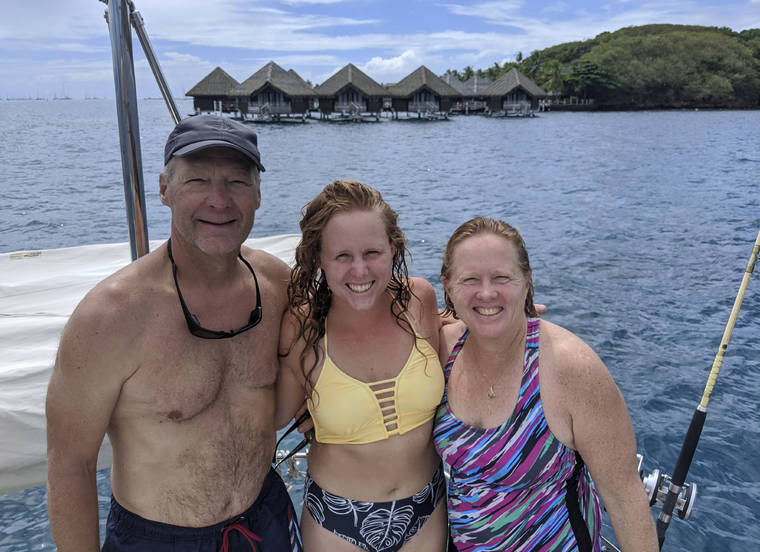Stranded in paradise: Hundreds of sailors stuck in Pacific due to coronavirus shutdown | Honolulu Star-Advertiser

Kristen Pankratz, center, poses with her parents David and Anne on their yacht Amazing Grace in Tahiti on April 23. Pankratz gave up her advertising job in Dallas and set sail with her parents in January. But now, along with hundreds of other sailors, the family finds themselves stranded in paradise. They made it as far as Tahiti in remote French Polynesia, one of the last places to offer refuge as borders slammed shut.
WELLINGTON, New Zealand >> For as long as she can remember, 28-year-old Kristen Pankratz has shared in her dad’s dream to sail around the world. Life somehow always got in the way. But after giving up her advertising job in Dallas, she finally set sail with her parents in January.
Now, along with hundreds of other sailors, they find themselves stranded in paradise. As they sailed west across the vast Pacific Ocean in March, the coronavirus pandemic spread its tentacles across the globe. They made it as far as Tahiti in remote French Polynesia, one of the last places in the region to offer refuge as borders slammed shut.
With South Pacific countries not yet ready to reopen, the family is finding no way forward, no way back, and doesn’t want to abandon their boat. So they remain where they are, in a strange limbo, hoping they can sail west again before the cyclone season hits in November.
There are some 550 sailboats currently sheltering in French Polynesia, according to a manifest kept by maritime authorities. Typically the boats have a crew of about two or three, although a few have 10 or more aboard. There are hundreds more sailors stranded elsewhere in the South Pacific, in Fiji, Tonga, New Zealand and Australia.
The Pankratzs say they’ve been treated extraordinarily well and have been able to see beautiful grottoes and black sand beaches without many other tourists around. Others say they’ve encountered suspicion and sometimes hostility from local residents fearful they might be bringing in the virus from abroad.
Kristen Pankratz said at first she felt sad their dream trip wasn’t going according to plan, but soon realized their situation could have been so much worse. She began feeling guilty about not being home with loved ones.
“When we first left, people at home were so scared for us,” she said. “But it turned out we ended up being safer than they were in the U.S.”
Pankratz, with parents David and Anne, set out on their 46-foot (14-meter) sailboat Amazing Grace from St. Lucia as part of a loose-knit group of sailors who had similar ambitions to circumnavigate the globe.
After sailing through the Panama Canal into the Pacific, they got sporadic updates from their satellite phone and from other sailors about the deteriorating virus situation. They ended up spending a week longer at sea than planned to get to Tahiti, catching fresh tuna along the way to stretch out their supplies.
Then came four and a half weeks of lockdown at a marina, where they were allowed off the boat only for exercise and groceries. Pankratz settled into a routine with some of the other sailors: high-intensity exercise classes at 7:30 a.m. on the dock; cocktails at 5:30 p.m. on the boats.
After the lockdown ended, they got to see more of Tahiti. And this week, they set sail for some new islands after authorities loosened restrictions to allow more travel between French Polynesia’s scattered archipelagos.
British sailors Rob and Frances Lythgoe spent their lockdown in a different part of French Polynesia, at Raiatea island. They said they hardly spoke to another soul for 10 weeks.
Rob Lythgoe said the mayor came out on a boat to tell them they could only come ashore one at a time and if they wore masks, despite local residents not wearing them. So they fashioned them out of a pillowcase.
Lythgoe, 57, said people on the islands were suspicious they might have brought the virus from Europe, even though they’d isolated themselves on their boat. One man told them they should leave. Lythgoe pointed out there’s a long and unfortunate history of foreigners bringing diseases to the South Pacific.
“Being white, middle-aged and middle-class, it’s the first time we’ve felt discrimination,” Lythgoe said, adding that it was an enlightening experience.
Like many others, the Lythgoes are hoping that New Zealand will eventually relax its border restrictions so they can sail there to get needed repairs to their boat and prepare for the next leg of their journey. They worry that sailboats are being unfairly lumped in with cruise ships as a possible source of infection.
Other sailors already in New Zealand say they have no passage out and are preparing to hunker down for the Southern Hemisphere winter.
Vandy Shrader, 58, from near San Francisco, said she and her husband Eric arrived in New Zealand in November on their 50-foot (15-meter) cutter Scoots, and planned to leave for Fiji about now. Instead, they’ve got their heater going in their boat at the Whangarei Town Basin Marina.
“We’re very happy to be here,” Shrader said. “I feel like we’ve won the lockdown lottery.”
That’s because New Zealand has almost eradicated the virus after enforcing a strict lockdown in March.
Shrader said she and her husband have been at sea for the best part of six years. They’re among a community of full-time cruisers who enjoy the lifestyle on “a big boat, but a small house.”
Shrader and other sailors say the ocean teaches you to be flexible and patient. Sometimes you have to ride out storms, other times you find yourself becalmed. She says they’ll wait to see what happens by September and perhaps set sail. But who knows? Maybe they’ll stay in New Zealand for another year.
It all depends on the virus. And the weather.